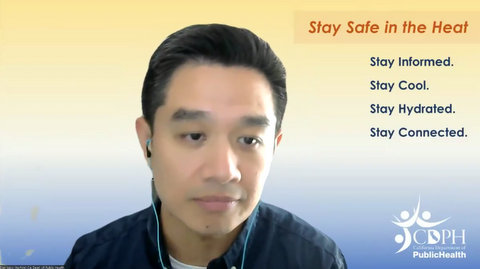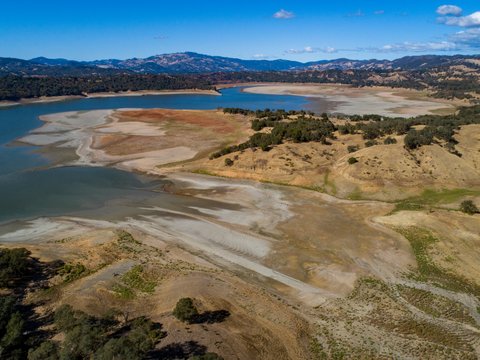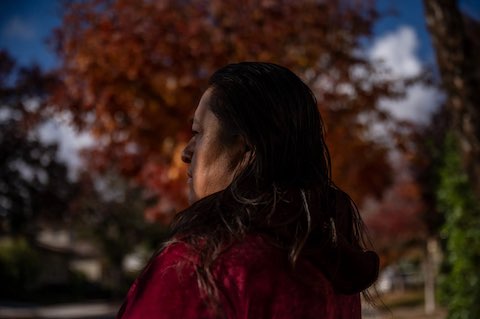
25 Jul State Highlights Extreme Heat, College Affordability Resources

Heat, in part due to climate change, is “making it more dangerous for our health and safety,” but it “doesn’t hit equally,” said Dan Woo of the California Department of Public Health at a July 16 state ethnic media forum. (Screenshot captured by Samantha Kennedy / The CC Pulse)
By Samantha Kennedy
Parts of California are experiencing another heat wave after only a brief break from record high temperatures for some in the state. Climate change is fueling these events, but officials don’t want residents to feel powerless against the heat.
“Many of us in California are no strangers to heat, but it is getting hotter out there,” said Dan Woo, a climate change and health equity team lead for the Office of Health Equity at the California Department of Public Health, at a July 16 state Office of Community Partnerships & Strategic Communications forum for ethnic media. Heat, in part due to climate change, is “making it more dangerous for our health and safety” because of the increase in extreme heat events.
The forum coincided with the first week of OCPSC’s Heat Ready CA Month of Action, which looks to inform residents who are the most affected by extreme heat through community outreach.
Though heat kills more than any other weather-related hazard, extreme heat “doesn’t hit equally,” according to Woo.
During California’s heat wave in September 2022, a 5% increase in deaths also included an increase in deaths among Hispanic Californians, working-age adults and those in the South Coast region.
In general, Woo says older adults, infants, those who are pregnant or have chronic health conditions, and those who have low financial resources are “especially sensitive to heat exposure.”
To stay safe in the heat, Californians can:
Stay Informed by checking local media and weather services for when extreme heat events are expected to occur, where cooling stations are, and what the signs of heat illnesses like heatstroke are.
Stay Cool by staying in air-conditioned areas as much as possible, or wearing lightweight and loose clothing, using sunscreen, and taking cold showers or baths. If staying in air-conditioned areas is not possible, keep your skin wet with a washcloth or bandanna.
Stay Hydrated by drinking fluids no matter how active you are and before you get thirsty.
Stay Connected by monitoring those around you in the high heat and having others keep an eye out for you.
Californians can also get ahead of extreme heat events by taking advantage of programs that offer energy assistance to low-income residents.
Chuck Belk, assistant deputy director of the energy division in the California Department of Community Services & Development, said CSD administers programs like the Low Income Home Energy Assistance Program that helps households with heating and cooling costs, bill payment and weatherization home repairs.
Households can find out if they are eligible for LIHEAP here.
Local energy providers may also offer discounts or assistance to eligible households, according to Belk, and he encourages residents to reach out to see what services may be offered.
CalKIDS Helps Youth Save for College
Certain California students can claim up to $1,500 toward college expenses, and the number of eligible students is only growing.
That’s thanks to the California Kids Investment and Development Savings program, or CalKIDS, which the state launched in 2022 as the country’s largest college savings program to pay for things like tuition, books and housing.
The program’s initial investment of $1.9 million was used to fund the college savings accounts of low-income students in first grade to 12th grade and every newborn born after July 1, 2022. Now, as previously ineligible students age, parents can begin claiming those newly available accounts.
“Going forward, we’re going to build upon these groups of students,” said Diane Lim, a data analyst with CalKIDS, at the July 16 forum, “by each year adding in incoming eligible first graders into the program.”
>>>Read: Student Loans or Living Expenses? Biden Administration Tries to Ease Debt Burden<<<
Lim said eligible students in first grade to 12th grade will automatically have $500 deposited into their accounts. If a student is homeless or a foster youth, an additional deposit of $500 — or $1,000 if a student is both — will be automatically deposited.
Savings accounts for newborns do not have income requirements, according to Lim, and each child born after July 1, 2022, is eligible for an automatic deposit of $25. Newborn accounts can receive additional deposits by registering online or linking the CalKIDS account to a separate college savings plan, a ScholarShare 529 account.
>>>Read: Student Debt Fuels Racial Wealth Gap, Advocates Say<<<
Lim says parents cannot add additional funding to a child’s CalKIDS account but can do so through a ScholarShare 529 account, which can be linked to a CalKIDS account.
Children do not have to have an individual taxpayer identification number to be eligible for a CalKIDS account.
Lim says the hope for the CalKIDS program is to last “a very long time.”
Students are able to request disbursement of the funds directly to an eligible institution when they are at least 17.
Find out if your child is eligible for a CalKIDS account here.






No Comments